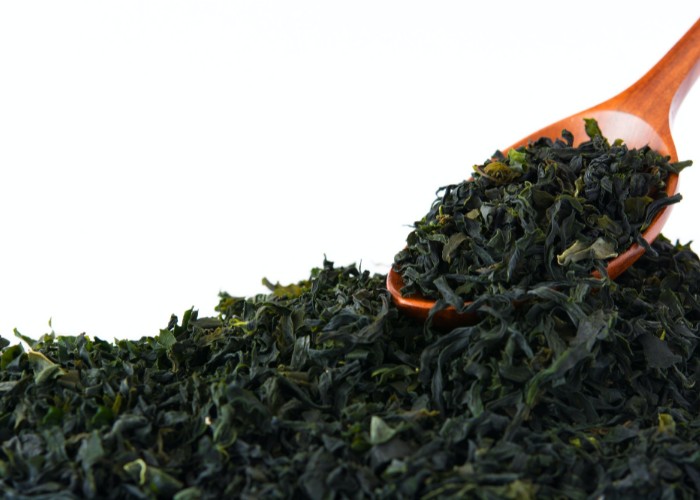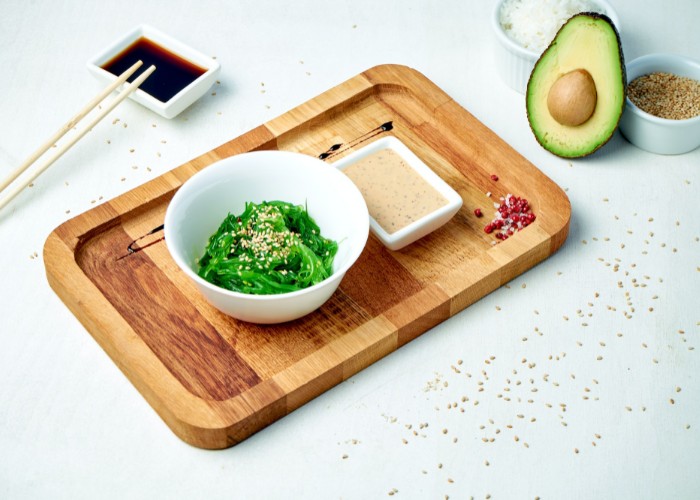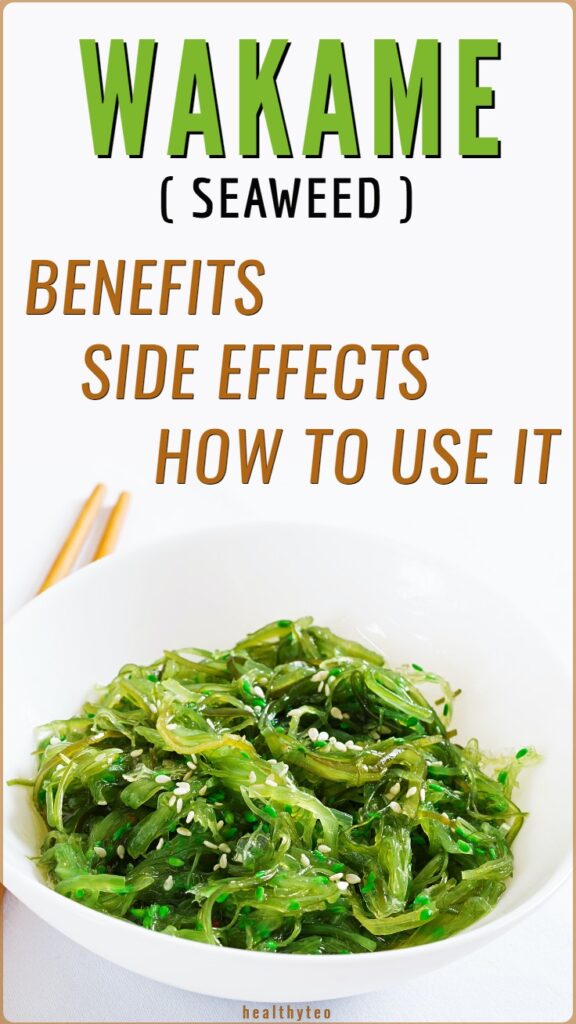Wakame seaweed: benefits and possible side effects of consuming this sea vegetable
Wakame seaweed has been used for thousands of years in Asian countries. It is still one of the main foods but now this seaweed is more often present in our Western world diets.
Because this seaweed is used in our meals more often it is good to learn what is this seaweed and what are the benefits of wakame.
If you don’t know where it comes from and how to use this nutritious and healthy seaweed you are in the right place.
Read here what are the benefits and possible side effects of wakame and how to use it for cooking.
This post may contain affiliate links, which means we may receive a small commission, at no cost to you, if you make a purchase through a link. For more information, please see our disclosure.
What is wakame?
Wakame or Undaria pinnatifida is a species of edible seaweed, a type of marine algae used in Japanese and other Asian cuisines.

There is a big chance that you already enjoying wakame without even knowing it. If you like Japanese, Korean or Chinese food you have eaten wakame in cold salads like sunomono (cucumber seaweed salad), or as a topping on tofu, rice, sushi, or soups.
The primary common name is derived from the Japanese name wakame, in English, it can be also called “sea mustard”. This is not because of its mild flavor, which, unlike the peppery vegetable, it’s because it resembles mustard greens when cooked.
Leading producers and consumers of wakame are Japan and Korea where sea-farmers have grown this superfood for centuries. Since 1983 it is also been cultivated in France, in sea fields established near the shores of Brittany.
Wild-grown wakame is harvested in Tasmania, Australia, and also hand-harvested in New Zealand.
Flavor – like most seaweeds it has a salty umami flavor, with a degree of sweetness as well.
Texture – rehydrated wakame has a slippery texture, slightly rubbery. Dried wakame straight from the bag resembles a slightly chewy potato chip.
Nutrition – Here’s a quick nutrition breakdown for 10 grams ( two tablespoons ) of raw wakame seaweed:
- Calories: 5
- Protein: 0.5 grams
- Carbs: 1 gram
- Calcium: 2% of the RDI
- Iodine: 280% of the RDI
- Manganese: 7% of the RDI
- Folate: 5% of the RDI
- Magnesium: 3% of the RDI
Benefits of wakame seaweed
Wakame is considered one of the healthiest sea vegetables. Full of minerals and vitamins the health benefits of the wakame list are long, here we will mention some of them that we think are most important.
Great source of iodine
Wakame is one of the highest food sources of iodine. The iodine content varies depending on where it is harvested, on average it contains 42 mcg of iodine per gram, and this is about 28% of the RDI (Recommended Dietary Intake).
If we make a comparison with other seaweeds wakame is not in the first place by its iodine content. The first place is for kombu seaweed.
Average iodine content in different seaweeds:
- Kombu – 2523.5 mg/kg
- Wakame – 139.7 mg/kg
- Nori – 36.9 mg/kg
What happens when you don’t get enough iodine? – Iodine is an essential mineral that is needed to make thyroid hormones in the body. If you don’t get enough of this mineral you can develop a goiter, which is the first sign of hypothyroidism.
What happens when you consume too much iodine? – If you do this on a regular basis, thyroid hormone synthesis is inhibited. Too much iodine can cause the same symptoms as iodine deficiency, including goiter, hypothyroidism, and elevated TSH levels. (Thyroid-Stimulating Hormone).
Fact to remember
Ingestion of greater than 1,100 mcg of iodine per day is not recommended and may cause thyroid dysfunction.
Can help with weight loss
Fucoxanthin is a carotenoid found in wakame, and some studies suggest that this ingredient present in wakame promotes fat burning within the fat cells of animals.
According to the study, fucoxanthin encourages the action of a protein that causes fat oxidation and is found in the type of fat that surrounds organs. It also promotes DHA production in the liver, which helps decrease bad cholesterol or LDL.
Wakame is often promoted as a weight loss aid and as a potential treatment for obesity. However, research investigating these benefits is still in the early stages.
Because most of the research is conducted on animals, additional studies are required to know how exactly wakame may affect weight in humans.
Rich in omega-3 fatty acids
Wakame seaweed is rich in omega-3 fatty acids which are beneficial to us in many ways. Omega-3 foods can be used to lower cholesterol, reduce anxiety, reduce inflammation, and promote skin health.
Today in the Western world consumption of omega-6 fats is bigger than omega-3 fats. It is important to consume more food rich in omega-3 fats and wakame is the perfect choice for that.
Good To Know
Wakame is the highest vegetarian source of omega-3s. The ratio between omega-6 and omega-3 in wakame is about 1 to 18.
Good for your heart
Although there is limited research on humans, animal studies show that wakame can reduce cholesterol. One study from 2017 conducted on humans reported improvements in triglycerides, LDL, and body weight in men who followed a healthy Japanese diet compared to a Western diet.
Animal studies have found that that wakame may lower cholesterol levels to help promote heart health. Despite these results understanding how wakame may affect cholesterol levels in humans requires further results.
It may help control insulin and blood sugar levels
Again research is still preliminary and it takes some time to be completely sure but a 2019 study, found that people with prediabetes who consumed 200 grams of rice with 4 grams of wakame had better post-meal blood sugar response than people who consumed only rice without wakame.
Animal studies confirmed that wakame is able to prevent insulin resistance – a condition when cells in your body don’t respond well to insulin and can’t use glucose from your blood for energy.
However, additional studies are needed to discover how wakame seaweed may impact blood sugar levels in humans.
Possible side effects
Consuming too much wakame may cause adverse side effects in some people.
Certain brands may contain high amounts of sodium that can act against potassium to lower blood pressure levels. People with blood pressure problems should be careful when adding wakame to their diet.
As we mentioned it’s high in iodine, although iodine is needed for the production of thyroid hormones, excess amounts can harm the health of your thyroid.
If you are taking any prescription medications, especially in the case of a thyroid disorder, consult your doctor before consuming wakame seaweed.
How to use wakame

Dried wakame needs to be rehydrated before using it. Simply place the seaweed into a bowl and cover it with warm water for a few minutes. It will expand a bit, so you don’t need to put a lot of it.
After rehydrating, the next you should do is drain and squeeze out the excess amount of water. Now your wakame is ready to add to salads, soups.
Another technique is to blanch the wakame seaweed. Blanching includes briefly immersing the dried wakame in boiling water, then draining it, and rinsing it with cold water before squeezing it dry.
We use blanching when we want to add wakame to a salad because this technique brings out the bright green color of the wakame.
Another way to use it is to add the dried stripes into a spice grinder and use it as a seasoning for fish, tofu, salads, and soups.
Storage
You can keep your dried wakame sealed in a bag it came in, in a cool, dry, and dark place for up to a year. After you rehydrate it, keep it in your fridge where it will last for 3-4 days.
Common questions
Wakame is different from nori. Nori is a type of seaweed used in making sushi. Wakame comes in a form of stripes a little bit like raisins from the sea. Nori comes in dried, flat sheets.
Due to high iodine content, if you consume too much seaweed over a long period of time it can have a negative effect on thyroid function.
Boiling seaweed in water for 15-30 minutes will reduce the iodine content. From all seaweeds, Kombu seaweed loses up to 99% of iodine content when boiled.
You can use wakame instead of kombu in dashi, but you won’t get the same umami kick. Wakame gets very slimy when it’s cooked and this can affect the texture of dashi, kombu has a thicker texture.

Final thoughts about consuming wakame and its benefits
Wakame is an edible seaweed, highly nutritious, and a good source of vitamins and minerals and if you haven’t tried it yet it is about time to add it to your diet.
A great choice for various recipes and excellent sources of iodine, the benefits of wakame seaweed are numerous. Wakame is good for your insulin and blood sugar levels, rich in omega-3 fatty acids, lowers cholesterol, helps with weight loss.
This seaweed has been used for thousands of years in Asian countries as food but also for medicinal purposes.
Today is mostly used dried wakame that needs to be rehydrated before adding to soups, salads, stir-fries, and many other recipes to create tasty and healthy meals.
Related articles with seaweed
- Kombu Seaweed: Powerful Sea Food – Benefits and Side Effects
- Benefits of Eating Dulse Seaweed – Secret Sea Vegetable
- Sea Moss: Benefits and Side Effects That You Should Know
- Nori Seaweed | Benefits, Side Effects and More
- Different Types Of Seaweed To Eat-How To Use Sea Vegetables




